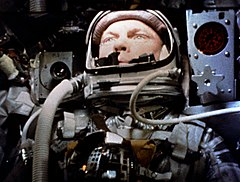
Back Mercury-Atlas 6 Afrikaans ميركوري-أطلس 6 Arabic Мъркюри 6 Bulgarian Mercury-Atlas 6 Catalan Mercury-Atlas 6 Czech Mercury-Atlas 6 German Mercury Atlas 6 Spanish مرکوری-اطلس ۶ Persian Mercury-Atlas 6 Finnish Mercury-Atlas 6 French
 Still frame of John Glenn in orbit, taken by a motion picture camera inside Friendship 7 | |
| Mission type | Test flight |
|---|---|
| Operator | NASA |
| Harvard designation | 1962 Gamma 1 |
| COSPAR ID | 1962-003A |
| SATCAT no. | 240 |
| Mission duration | 4 hours, 55 minutes, 23 seconds[1] |
| Distance travelled | 65,763 nautical miles (121,793 km) |
| Orbits completed | 3 |
| Spacecraft properties | |
| Spacecraft | Mercury No.13 |
| Manufacturer | McDonnell Aircraft |
| Launch mass | 2,981 pounds (1,352 kg)[2] |
| Crew | |
| Crew size | 1 |
| Members | John H. Glenn, Jr |
| Callsign | Friendship 7 |
| Start of mission | |
| Launch date | February 20, 1962, 14:47:39 UTC |
| Rocket | Atlas LV-3B 109-D |
| Launch site | Cape Canaveral LC-14 |
| End of mission | |
| Recovered by | USS Noa |
| Landing date | February 20, 1962, 19:43:02 UTC |
| Landing site | North Atlantic Ocean 21°20′N 68°40′W / 21.333°N 68.667°W |
| Orbital parameters | |
| Reference system | Geocentric |
| Regime | Low Earth orbit |
| Perigee altitude | 80 nautical miles (150 km) |
| Apogee altitude | 134 nautical miles (248 km) |
| Inclination | 32.5 degrees |
| Period | 88.47 minutes |
| Epoch | February 20, 1962[3] |

Project Mercury Crewed missions | |
Mercury-Atlas 6 (MA-6) was the first crewed American orbital spaceflight, which took place on February 20, 1962.[4] Piloted by astronaut John Glenn and operated by NASA as part of Project Mercury, it was the fifth human spaceflight, preceded by Soviet orbital flights Vostok 1 and 2 and American sub-orbital flights Mercury-Redstone 3 and 4.[5]
The Mercury spacecraft, named Friendship 7, was carried to orbit by an Atlas LV-3B launch vehicle lifting off from Launch Complex 14 at Cape Canaveral, Florida. After three orbits, the spacecraft re-entered the Earth's atmosphere, splashed down in the North Atlantic Ocean, and was safely taken aboard USS Noa. The total mission flight time was 4 hours 55 minutes and 23 seconds.
- ^ "Mercury-Atlas 6". NASA. November 20, 2006. Retrieved November 15, 2018.
- ^ "Mercury Atlas 6 NSSDCA/COSPAR ID: 1962-003A". NASA.
- ^ McDowell, Jonathan. "SATCAT". Jonathan's Space Pages. Retrieved March 23, 2014.
- ^ "Mercury-Atlas 6 Press Conference (1962)". Texas Archive of the Moving Image. Retrieved December 1, 2019.
- ^ Swenson, Loyd S. Jr.; Grimwood, James M.; Alexander, Charles C. (1989). "13-4 An American in Orbit". In Woods, David; Gamble, Chris (eds.). This New Ocean: A History of Project Mercury. NASA. SP-4201. Archived from the original on April 5, 2023. Retrieved July 14, 2009.